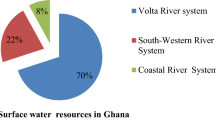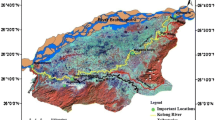Abstract
The Middle Route of China’s South-to-North Water Transfer (MSNW) and Yangtze-Han River Water Diversion (YHWD) Projects have been operated since 2014, which may deteriorate water quality in Han River. The 11 water samples along the middle and down streams of the Han River watershed were collected monthly from July 2014 to June 2016 to investigate the major pollution types and main variables influencing the water quality in the Han River using factor and cluster analysis approaches. The factor analysis identified three main pollution types (agricultural nonpoint source, organic, and phosphorus point source pollution) in the Han River while the cluster analysis classified all sampling sites into four groups and determined seasonal (dry and wet) pollution sources. The water quality at the sites nearby the city was dominated by point source pollution while nonpoint source pollution from Jianghan Plain prominently contributed to the water quality at the downstream sites except for city sites. Variations of water qualities are influenced by hydrological conditions that are dependent on operations of engineering projects and seasonal variability, especially in the dry season. Good water quality (defined as Class III or low levels) mainly occurred when the flow rate is greater than 800 m3/s during the dry season. The average flow rate below 583 m3/s may degrade water quality as Class V appeared at all monitoring sites under this condition. Given low flow conditions, thus, an increase in flow discharges from the MSNW and YHWD Projects may enhance the water quality for the Han River and further prevent algal blooms. The relationship between water quality and flow rate investigated in this study may provide useful information to develop sustainable water quality management under various flow conditions.







Similar content being viewed by others
References
Ahearn DS, Sheibley RS, Dahlgren RA, Anderson M, Jonson J, Tate KW (2005) Land use and land cover influence on water quality in the last free flowing river draining the western Sierra Nevada, California. J Hydrol 313:234–247
Atkins R, Rose T, Brown RS, Robb M (2001) The Microcystis cyanobacteria bloom in the Swan river—February 2000. Water Sci Technol 43(9):107–114
Bates MH, Neafus NJ (1980) Phosphorus release from sediments from Lake Carl Blackwell, Oklahoma. Water Res 14:1477–1481
Bu HM, Wan J, Zhang Y, Meng W (2013) Spatial characteristics of surface water quality in the Haicheng River (Liao River basin) in Northeast China. Environ Earth Sci 70:2865–2872
Carpenter SR, Caraco NF, Correll DL, Howarth RW, Sharpley AN, Smith VH (1998) Nonpoint pollution of surface waters with phosphorus and nitrogen. Ecol Appl 8(3):559–568
Chou WS, Lee TC, Lin JY, Yu SL (2007) Phosphorus load reduction goals for feitsui reservoir watershed, Taiwan. Environ Monit Assess 131:395–408
Edet A, Ukpong A, Nganje T (2013) Hydrochemical studies of cross river basin (southeastern Nigeria) river systems using cross plots, statistics and water quality index. Environ Earth Sci 70:3043–3056
Forshay KJ, Stanley EH (2005) Rapid nitrate loss and denitrification in a temperate river floodplain. Biogeochemistry 75:43–64
Helena B, Pardo R, Vega M, Barrado E, Fernandez JM, Fernandez L (2000) Temporal evolution of groundwater composition in an alluvial aquifer (Pisuerga River, Spain) by principal component analysis. Water Res 34:807–816
Huang H, Yu Y, Jing L, Wang X, Feng J, Niu H, Xiao Q, Wang L (2004) Semivolatile organic pollutants in water, suspended solids, and surface sediments of the Huaihe River, Jiangsu section, People’s Republic of China. Bull Environ Contam Toxicol 73:339–346
Huang F, Wang XQ, Lou LP, Zhou ZQ, Wu JP (2009) Spatial variation and source apportionment of water pollution in Qiantang River (China) using statistical techniques. Water Res 44:1562–1572
Hutchinson GE (1957) A treatise on limnology, geography, physics and chemistry, vol 1. Wiley, New York
Jarvie HP, Neal C, Jürgens MD, Sutton EJ, Neal M, Wickham HD, Hill LK, Harman SA, Davies JJL, Warwick A, Barrett C, Griffiths J, Binley A, Swannack N, Mc IN (2006) Within–river nutrient processing in chalk streams: the Pang and Lambourn, UK. J Hydrol 330:101–125
Jayakumar R, Siraz L (1997) Factor analysis in hydro geochemistry of coastal aquifers—a preliminary study. Environ Geochem 31(3/4):174–177
Jiang X, Huang W, Liu C, Huang Q (2004) Water supply need analysis for the lower Yellow River. Water Int 29:415–422
Kannel PR, Lee S, Kanel SR, Khan SP (2007) Chemometric application in classification and assessment of monitoring locations of an urban river system. Anal Chim Acta 582:390–399
Kim JH, Kim RH, Lee J, Cheong TJ, Yum BW, Chang HW (2005) Multivariate statistical analysis to identify the major factors governing groundwater quality in the coastal area of Kimje, South Korea. Hydrol Process 19:1261–1276
Kuo YM, Jang CS, Yu HL, Chen SC, Chu HJ (2013) Identifying nearshore groundwater and river hydrochemical variables influencing water quality of Kaoping River Eestuary using dynamic factor analysis. J Hydrol 486:39–47
Lattin JM, Carroll JD, Green PE (2003) Analyzing multivariate data, vol 17. Duxbury Press, New York, pp 1205–1212
Li S, Gu S, Liu W, Han H, Zhang Q (2008a) Water quality in relation to the land use and land cover in the upper Han River basin, China. CATENA 75:216–222
Li S, Xu Z, Cheng X, Zhang Q (2008b) Dissolved trace elements and heavy metals in the Danjiangkou reservoir, China. Environ Geol 55:977–983
Li JX, Wang YX, Xie XJ, Su CL (2012) Hierarchical cluster analysis of arsenic and fluo–ride enrichments in groundwater from the Datong basin, northern China. J Geochem Explor 118:77–89
Lin YC, Chang-Chien GP, Chiang PC, Chen WH, Lin YC (2013) Multivariate analysis of heavy metal contaminations in seawater and sediments from a heavily industrialized harbor in southern Taiwan. Mar Pollut Bull 76:266–275
Liu CW, Lin KH, Kuo YM (2003) Application of factor analysis in the assessment of groundwater quality in a blackfoot disease area in Taiwan. Sci Total Environ 313:77–89
Luo P, He B, Takara K, Razafindrabe BHN, Nover D, Yamashiki Y (2011) Spatiotemporal trend analysis of recent river water quality conditions in Japan. J Environ Monit 13:2819–2829
McKenna J (2003) An enhanced cluster analysis program with bootstrap significance testing for ecological community analysis. Environ Modell Softw 18:205–220
Mills CA, Mann RHK (1985) Environmentally–induced fluctuations in year–class strength and their implications for management. J Fish Biol 27(Suppl A):209–226
OECD (1982) Eutrophication of waters: monitoring, assessment and control. Organisation for Economic and Cooperative Development, Paris, France
Papatheodorou G, Lambrakis N, Panagopoulos G (2007) Application of multivariate statistical procedures to the hydrochemical study of a coastal aquifer: an example from Crete, Greece. Hydrol Process 21:1482–1495
Pinay G, Gumiero B, Tabacchi E, Gimenez O, Tabacchi-Planty AM, Hefting MM, Burt TP, Black VA, Nilsson C, Iordache V, Bureau F, Vought L, Petts GE, Décamps H (2007) Patterns of denitrification rates in European alluvial soils under various hydrological regimes. Freshwater Biol 52:252–266
Poff NL, Allan JD, Bain MD, Karr JR, Prestegaard KL, Richter BL, Sparks RE, Stromber JC (1997) The natural flow regime: a paradigm for river conservation and restoration. Bioscience 47:769–784
Poff NL, Olden JD, Merrit DM, Pepin DM (2007) Homogenization of regional river dynamics by dams and global biodiversity implications. Proc Natl Acad Sci USA 104:5732–5737
Prathumratana L, Sthiannopkao S, Kim KW (2008) The relationship of climatic and hydrological parameters to surface water quality in the lower Mekong River. Environ Int 34:860–866
Reisenhofer E, Adami G, Barbieri P (1998) Using chemical and physical parameters to define the quality of karstic fresh waters (Timavo River, north–eastern Italy): a chemometric approach. Water Res 32:1193–1203
Reynolds DM (2002) The differentiation of biodegradable and non–biodegradable dissolved organic matter in wastewaters using fluorescence spectroscopy. J Chem Technol Biotechnol 77(8):965–972
Sarkar PK, Bidwell OW, Marcus LF (1986) Selection of characteristics for numerical classification of soils. Soil Sci Soc Am J 30:269–272
Shen YN, Lu J, Chen DJ, Shi YM (2011) Response of stream pollution characteristics to catchment land covers in Cao-E River basin, China. Pedosphere 21:115–123
Singh KP, Malik A, Mohan D, Sinha S (2004) Multivariate statistical techniques for the evaluation of spatial and temporal variations in water quality of Gomti River (India): a case study. Water Res 38:3980–3992
Smith VH, Tilman GD, Nekola JC (1999) Eutrophication: impacts of excess nutrient inputs on freshwater, marine, and terrestrial ecosystems. Environ Pollut 100:179–196
Vega M, Pardo R, Barrado E, Deban L (1998) Assessment of seasonal and polluting effects on the quality of river water by exploratory data analysis. Water Res 32(12):3581–3592
Vollenweider RA (1968) Scientific fundamentals of the eutrophication of lakes and flowing waters, with particular reference to nitrogen and phosphorus as factors in eutrophication. In: Representatives Organization for Economic Cooperation and Development, Paris, DAS/CSI/68.27.
Wang SW, Kuo YM, Kao YH, Jang CS, Maji SK, Chang FJ, Liu CW (2011) Influence of hydrological and hydrogeochemical parameters on arsenic variation in shallow groundwater of southwestern Taiwan. J Hydrol 408:286–295
Ward JH (1963) Hierarchical grouping to optimize an objective function. J Am Stat Assoc 58(301):236–244
Xie H, Zafiriou OC, Cai W, Zepp RG, Wang Y (2004) Photooxidation and its effects on the carboxyl content of dissolved organic matter in two coastal rivers in the southeastern United States. Environ Sci Technol 38(15):4113–4119
Yang X, Shang C, Westerhoff P (2007) Factors affecting formation of haloacetonitriles, haloketones, chloropicrin and cyanogens halides during chloramination. Water Res 41:1193–2000
Yang N, Mei Y, Zhou C (2012) An optimal reservoir operation model based on ecological requirement and its effect on electricity generation. Water Resour Manage 26:4019–4028
Zhang C, Dong SH (2009) A new water quality assessment model based on projection pursuit technique. J Environ Sci S1:154–157
Zhang L, She Z, Zhang S (1996) Study of chemical elements in water environment. Chinese Environment Science Press, Beijing, China
Zhang W, Wei X, Zheng J, Zhu Y, Zhang Y (2012) Estimating suspended sediment loads in the Pearl River Delta region using sediment rating curves. Cont Shelf Res 38(15):35–46
Zhao H, Li X, Wang X, Tian D (2010) Grain size distribution of road–deposited sediment and its contribution to heavy metal pollution in urban runoff in Beijing, China. J Hazard Mater 183:203–210
Zhong H, Kraemer L, Evans D (2012) Effects of aging on the digestive solubilization of Cu from sediments. Environ Pollut 164:195–203
Zhou Y (2009) Pesticide transport and enrichment in water–soil environment: a case study of Jianghan Plain. A dissertation submitted to China University of Geosciences for the Doctor Degree of Philosophy, vol 118, pp 77–89
Acknowledgements
This research was financially supported by the National Natural Science Foundation of China (Grant No. 41877534), CRSRI Open Research Program (CKWV2018491/KY), the Fundamental Research Funds for the Central Universities, China University of Geosciences (Wuhan) (CUGCJ1704), the Natural Science Foundation of Hubei Province of China (2015CFA050), and the China Geological Survey Project (12120114069301, 121201001000150121). The authors would like to express their gratitude to EditSprings (https://www.editsprings.com/) for the expert linguistic services provided.
Author information
Authors and Affiliations
Corresponding authors
Additional information
Publisher's Note
Springer Nature remains neutral with regard to jurisdictional claims in published maps and institutional affiliations.
Rights and permissions
About this article
Cite this article
Liu, Ww., Kuo, YM. & Zhao, E. Influence of the south-to-north water transfer and the Yangtze River mitigation projects on the water quality of Han River, China. Environ Earth Sci 80, 246 (2021). https://doi.org/10.1007/s12665-021-09534-5
Received:
Accepted:
Published:
DOI: https://doi.org/10.1007/s12665-021-09534-5




